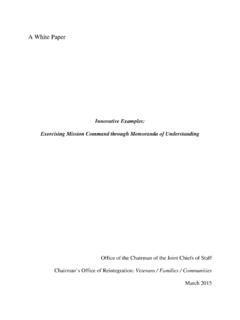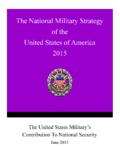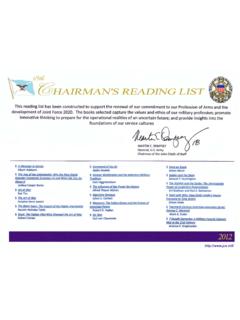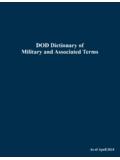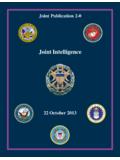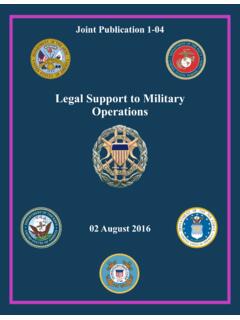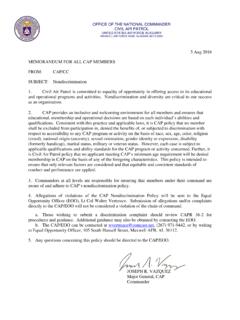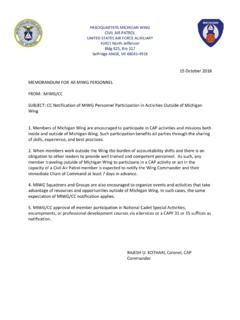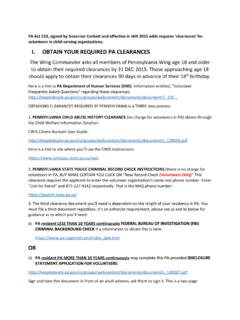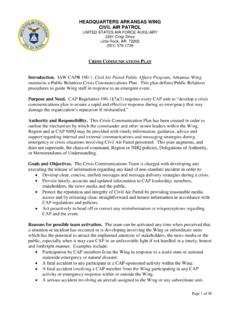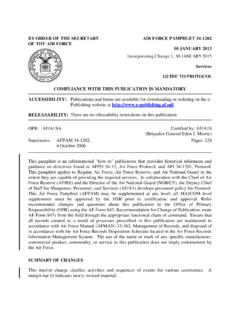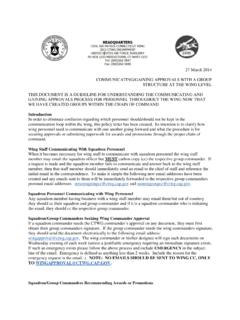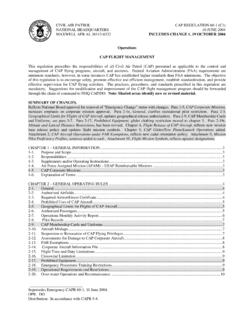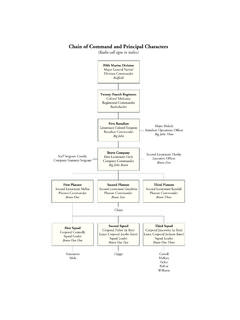Transcription of JP 3-16, Multinational Operations
1 Joint Publication 3-16. Multinational Operations 16 July 2013. PREFACE. 1. Scope This publication provides doctrine for the Armed Forces of the United States when they operate as part of a Multinational force. It addresses operational considerations that the commander and staff should consider during the planning and execution of Multinational Operations . 2. Purpose This publication has been prepared under the direction of the Chairman of the Joint Chiefs of Staff (CJCS). It sets forth joint doctrine to govern the activities and performance of the Armed Forces of the United States in joint Operations and provides the doctrinal basis for US military coordination with other US Government departments and agencies during Operations and for US military involvement in Multinational Operations . It provides military guidance for the exercise of authority by combatant commanders and other joint force commanders (JFCs) and prescribes joint doctrine for Operations and training.
2 It provides military guidance for use by the Armed Forces in preparing their appropriate plans. It is not the intent of this publication to restrict the authority of the JFC from organizing the force and executing the mission in a manner the JFC deems most appropriate to ensure unity of effort in the accomplishment of the overall objective. 3. Application a. Joint doctrine established in this publication applies to the Joint Staff, commanders of combatant commands, subunified commands, joint task forces, subordinate components of these commands, and the Services. b. The guidance in this publication is authoritative; as such, this doctrine will be followed except when, in the judgment of the commander, exceptional circumstances dictate otherwise. If conflicts arise between the contents of this publication and the contents of Service publications, this publication will take precedence unless the CJCS, normally in coordination with the other members of the Joint Chiefs of Staff, has provided more current and specific guidance.
3 Commanders of forces operating as part of a Multinational (alliance or coalition) military command should follow Multinational doctrine and procedures ratified by the United States. For doctrine and procedures not ratified by the United States, commanders should evaluate and follow the Multinational command 's doctrine and procedures, where applicable and consistent with US law, regulations, and doctrine. For the Chairman of the Joint Chiefs of Staff: CURTIS M. SCAPARROTTI. Lieutenant General, Army Director, Joint Staff i Preface Intentionally Blank ii JP 3-16. SUMMARY OF CHANGES. REVISION OF JOINT PUBLICATION 3-16. DATED 07 MARCH 2007. Updates discussion on security cooperation to align with proponent Joint Publication (JP) 3-22, Foreign Internal Defense, and JP 1-02, DOD Dictionary of Military and Associated Terms. Removes and replaces the term strategic communications and/or SC with communication synchronization throughout the JP.
4 Utilizes the term Multinational throughout the document to represent the myriad of terms that could be used to describe the force. Deletes the National Security Structure section at the beginning of Chapter II, command and Coordination Relationships.. Replaces the term psychological Operations throughout the publication with the term military information support Operations as appropriate, which more accurately reflects and coveys the nature of planned peacetime or combat Operations activities, per Secretary of Defense Memorandum dated 3 December 2010. Deletes the Strategic Communications section. Updates and cleans up graphics and diagrams throughout the JP. Removes old Appendix C, United Nations and Other Intergovernmental Organizations Considerations.. Adds new Appendix C, Multinational Interoperability Council.. iii Summary of Changes Intentionally Blank iv JP 3-16.
5 TABLE OF CONTENTS. PAGE. EXECUTIVE SUMMARY .. ix CHAPTER I. FUNDAMENTALS OF Multinational Operations . Multinational Operations Overview .. I-1. Strategic Context .. I-1. Nature of Multinational Operations .. I-3. Security Cooperation .. I-4. Security Cooperation Considerations .. I-5. Rationalization, Standardization, and Interoperability .. I-6. CHAPTER II. command AND COORDINATION RELATIONSHIPS. command and Control of United States Forces in Multinational Operations ..II-1. Unified Action ..II-2. Multinational Force and Multinational Force Commander ..II-3. Overview of Multinational command ..II-4. Multinational command Structures ..II-7. Multinational Coordination ..II-8. Control of Multinational Operations ..II-15. Interorganizational Coordination ..II-15. CHAPTER III. PLANNING AND EXECUTION CONSIDERATIONS. Section A. General Considerations.
6 III-1. Diplomatic and Military Considerations .. III-1. Building and Maintaining a Multinational III-3. Mission Analysis and Assignment of Tasks .. III-5. Language, Culture, and Sovereignty .. III-6. Legal .. III-8. Doctrine and Training .. III-10. Funding and Resources .. III-10. Protection of Personnel, Information, and Critical Assets .. III-10. Rules of Engagement .. III-12. Combat Identification and Friendly Fire Prevention .. III-12. Section B. Operational Considerations .. III-13. Intelligence .. III-13. Information Sharing .. III-17. Communications .. III-20. Operational Environment .. III-22. v Table of Contents Stability Operations .. III-32. Special Operations .. III-33. Civil Affairs III-33. Joint Fires .. III-36. Electromagnetic Spectrum Management .. III-37. Multinational Communications Integration .. III-37. Public Affairs.
7 III-39. Multinational Logistics .. III-40. Chemical, Biological, Radiological, and Nuclear Operations .. III-41. Counterdrug Operations .. III-42. Personnel Recovery .. III-42. Section C. Other Considerations .. III-43. Host-Nation Support .. III-43. Health Services .. III-45. Noncombatant Evacuation Operations .. III-47. Personnel Support .. III-48. Meteorology and Oceanography .. III-48. Environmental .. III-49. III-50. Foreign Humanitarian Assistance .. III-53. APPENDIX. A Planning Considerations .. A-1. B Multinational Planning Augmentation Team ..B-1. C Multinational Interoperability D References .. D-1. E Administrative Instructions .. E-1. GLOSSARY. Part I Abbreviations and Acronyms .. GL-1. Part II Terms and Definitions .. GL-5. FIGURE. I-1 Range of Military Operations .. I-2. II-1 Notional Multinational command Structure.
8 II-1. II-2 Notional Coalition command and Control Structure ..II-3. II-3 Integrated command Structure ..II-5. II-4 Lead Nation command Structure ..II-5. II-5 Parallel command Structure ..II-6. II-6 Coalition command Relationships for Operation DESERT STORM ..II-9. II-7 International Security Assistance Force Coalition command Relationships ..II-10. vi JP 3-16. Table of Contents II-8 International Security Assistance Force Afghanistan Coalition command Relationships ..II-11. II-9 Stabilization Force Coalition command Relationships ..II-12. II-10 European Forces Coalition command III-1 Factors Affecting the Military Capabilities of Nations .. III-2. III-2 Partner Nation Contributions .. III-4. III-3 Multinational Intelligence Principles .. III-14. III-4 Multinational Force Land Component Commander Notional Responsibilities .. III-23.
9 III-5 Multinational Force Maritime Component Commander Notional Responsibilities .. III-25. III-6 Multinational Force Air Component Commander Notional Responsibilities .. III-27. III-7 Multinational Force Special Operations Component Commander Notional Responsibilities .. III-34. III-8 Multinational Communication Integration .. III-38. III-9 Health Services Challenges in Multinational Operations .. III-47. III-10 Notional Operation Plan Phases .. III-51. III-11 Notional Transitions of Authority .. III-52. B-1 Multinational Planning Augmentation Team Augmentation Roles ..B-2. vii Table of Contents Intentionally Blank viii JP 3-16. EXECUTIVE SUMMARY. COMMANDER'S OVERVIEW. Presents Fundamentals of Multinational Operations Identifies command and Coordination Relationships Describes Planning and Execution Considerations Fundamentals of Multinational Operations Multinational Operations Multinational Operations are Operations conducted by Overview forces of two or more nations, usually undertaken within the structure of a coalition or alliance.
10 Other possible arrangements include supervision by an intergovernmental organization (IGO) such as the United Nations (UN), the North Atlantic Treaty Organization (NATO), or the Organization for Security and Cooperation in Europe. Two primary forms of Multinational partnership that the joint force commander (JFC) will encounter are an alliance or a coalition. An alliance is the relationship that results from a formal agreement between two or more nations for broad, long-term objectives that further the common interests of the members. A coalition is an arrangement between two or more nations for common action. Strategic Context Nations form partnerships in both regional and worldwide patterns as they seek opportunities to promote their mutual national interests, ensure mutual security against real and perceived threats, conduct foreign humanitarian assistance and disaster relief Operations , and engage in peace Operations .

